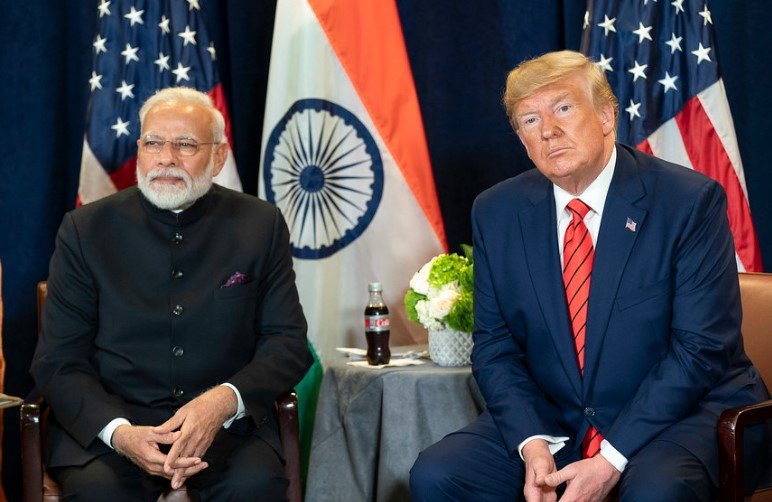India and the U.S. are racing against the clock. As negotiations over a long-stalled bilateral trade pact stretch into their final week, President Donald Trump dropped his clearest signal yet that a breakthrough may be close — and that the deal, if it lands, could come with deep tariff cuts.
“We’re going to have a deal,” he said. “And it’s going to be different.”
The comment, made during a campaign stop in Michigan on Monday, was brief but heavy with implication. With just days left before a 90-day moratorium on escalating trade tariffs expires, Trump’s off-the-cuff optimism may either preface a major policy win — or set the stage for yet another stalemate in one of the world’s most complex bilateral relationships.
A Race to the Finish Line
Talks between New Delhi and Washington have been intensifying behind closed doors since April. That’s when both sides agreed to a temporary freeze on retaliatory tariffs triggered during past disputes — most notably over digital service taxes, agricultural goods, and medical devices.
Now that pause is nearing its July 9 deadline.
India’s Commerce Ministry has been tight-lipped about the state of play. Officials have confirmed progress but stopped short of claiming a breakthrough. U.S. Trade Representative Katherine Tai’s office, too, has kept things vague. Still, there are hints the outlines of a deal may be taking shape.

At the heart of the impasse? Tariffs, of course — but not just that. From agricultural market access to e-commerce regulation, and from digital data localization rules to intellectual property protections, the list of grievances has piled up over the years.
Trump’s Messaging vs Reality
Trump’s comments, while characteristically blunt, hint at a core American complaint: that India’s domestic markets remain too protectionist.
“Right now, India does not accept anybody in,” he said, referring to foreign competition. “I think India is going to do that.”
That’s not entirely accurate — the U.S. exported more than $50 billion worth of goods and services to India last year, and India imported billions in American technology, arms, aircraft, and oil. But Trump’s claim touches a nerve in U.S. business circles that have long pushed for deeper market access and fewer tariffs in sectors like dairy, energy, and retail.
If a new deal leads to reduced duties on American goods, it could bolster U.S. exporters — and help Trump court farm and manufacturing voters ahead of the November election.
What’s at Stake for India?
New Delhi, for its part, has plenty riding on the outcome, too.
India is still not part of any major free trade agreement with the U.S. or EU. And while the Modi government has signed recent trade pacts with Australia and the UAE, a successful BTA with Washington would send a powerful signal: that India can play hardball — and win — at the highest level of global trade politics.
But there are concerns, too.
Indian officials worry that bowing to U.S. pressure on digital trade and data localization could hurt its nascent tech ecosystem. New Delhi also remains cautious about exposing its farmers to subsidized American agricultural imports.
In short, any deal that comes out of this will need to be carefully balanced — more a patchwork than a sweeping overhaul.
Possible Deal Contours
Some of the elements being negotiated, according to trade insiders close to the matter:
-
Tariff Reductions: Both sides may agree to reduce or eliminate certain retaliatory tariffs imposed during earlier trade disputes — like those on apples, almonds, and motorcycles.
-
Digital Economy Commitments: A softening of India’s stance on cross-border data flows may be met with U.S. flexibility on digital taxes.
-
Medical Device Access: Price caps on U.S.-made stents and implants — a longstanding USTR complaint — may be relaxed under a new regulatory framework.
-
Pharmaceuticals and IP: India may move to tighten its intellectual property laws to align more closely with U.S. expectations, particularly in generics.
One trade expert familiar with the negotiations said the final deal would likely be “limited in scope but politically significant,” especially as Trump ramps up his re-election bid and Modi consolidates power post-elections.
The Clock Is Ticking
Time, though, is running out. The temporary truce on new tariffs expires July 9 — just one week away.
If no agreement is reached, both countries could revert to tit-for-tat tariff hikes that soured relations during Trump’s first term. That would hit U.S. agricultural exporters and Indian steel producers hardest, while sending a chilly signal to multinational investors already spooked by global protectionism.
A key moment could come later this week, when senior USTR and Indian commerce ministry officials are expected to hold another virtual meeting. Whether that results in a breakthrough or a breakdown remains to be seen.
The Biden administration had largely left trade talks on autopilot during its early months, prioritizing climate and strategic partnerships instead. But Trump’s political re-emergence — and his growing dominance over the Republican field — has prompted renewed urgency to settle unresolved issues before November.
What Could Happen Next?
The possible outcomes range from underwhelming to historic. If a deal is struck, it could be announced jointly during a high-profile meeting — possibly around the July 4 weekend — and framed as a symbol of economic and strategic convergence.
But if talks collapse, the narrative may quickly flip. Trump could use the failure as campaign fodder, slamming both Indian trade policy and Biden’s inability to seal the deal, even after Modi’s official visit to Washington last year.
There’s also a slim possibility of another temporary tariff freeze to buy more time — though both governments are reportedly reluctant to prolong the limbo.
Whatever happens, the next seven days will be telling.
